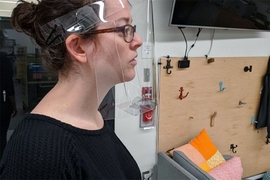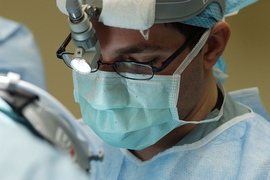When the Covid-19 crisis hit the United States this March, MIT neuroscientist Jill Crittenden wanted to help. One of her greatest concerns was the shortage of face masks, which are a key weapon for health care providers, frontline service workers, and the public to protect against respiratory transmission of Covid-19. For those caring for Covid-19 patients, face masks that provide a near-100 percent seal are essential. These critical pieces of equipment, called N95 masks, are now scarce, and health-care workers are now faced with reusing potentially contaminated masks.
To address this, Crittenden joined a team of 60 scientists and engineers, students, and clinicians drawn from universities and the private sector to synthesize the scientific literature about mask decontamination and create a set of best practices for bad times. The group has now unveiled a website, N95decon.org, which provides a summary of this critical information.
“I first heard about the group from Larissa Little, a Harvard graduate student with John Doyle,” explains Crittenden, who is a research scientist in Ann Graybiel's lab at the McGovern Institute for Brain Research at MIT. “The three of us began communicating because we are all also members of the Boston-based MGB Covid-19 Innovation Center, and we agreed that helping to assess the flood of information on N95 decontamination would be an important contribution.”
The team members who came together over several weeks scoured hundreds of peer-reviewed publications and held continuous online meetings to review studies of decontamination methods that had been used to inactivate previous viral and bacterial pathogens, and to then assess the potential for these methods to neutralize the novel SARS-CoV-2 virus that causes Covid-19.
“This group is absolutely amazing,” says Crittenden. “The Zoom meetings are very productive because it is all data- and solutions-driven. Everyone throws out ideas, what they know and what the literature source is, with the only goal being to get to a data-based consensus efficiently.”
Reliable resource
The goal of the consortium was to provide overwhelmed health officials, who don’t have the time to study the literature for themselves, reliable, pre-digested scientific information about the pros and cons of three decontamination methods that offer the best options should local shortages force a choice between decontamination and reuse, or going unmasked.
The three methods involve (1) heat and humidity, (2) a specific wavelength of light called ultraviolet C (UVC), and (3) treatment with hydrogen peroxide vapors (HPV). The scientists did not endorse any one method, but instead sought to describe the circumstances under which each could inactivate the virus provided rigorous procedures were followed. Devices that rely on heat, for instance, could be used under specific temperature, humidity, and time parameters. With UVC devices — which emit a particular wavelength and energy level of light — considerations involve making sure masks are properly oriented to the light so the entire surface is bathed in sufficient energy. The HPV method has the potential advantage of decontaminating masks in volume, as the U.S. Food and Drug Administration, acting in this emergency, has certified certain vendors to offer hydrogen peroxide vapor treatments on a large scale. In addition to giving health officials the scientific information to assess the methods best suited to their circumstances, N95decon.org points decision-makers to sources of reliable and detailed how-to information provided by other organizations, institutions, and commercial services.
“While there is no perfect method for decontamination of N95 masks, it is crucial that decision-makers and users have as much information as possible about the strengths and weaknesses of various approaches,” says Manu Prakash, an associate professor of bioengineering at Stanford University, who helped coordinate this ad hoc, volunteer undertaking. “Manufacturers currently do not recommend N95 mask reuse. We aim to provide information and evidence in this critical time to help those on the front lines of this crisis make risk-management decisions given the specific conditions and limitations they face.”
The researchers stressed that decontamination does not solve the N95 shortage, and expressed the hope that new masks should be made available in large numbers as soon as possible so that health-care workers and first providers could be issued fresh protective gear whenever needed as specified by the non-emergency guidelines set by the U.S. Centers for Disease Control and Prevention.
Forward thinking
Meanwhile, these ad hoc volunteers have pledged to continue working together to update the N95decon.org website as new information becomes available, and to coordinate their efforts to do research to plug the gaps in current knowledge to avoid duplication of effort.
“We are, at heart, a group of people that want to help better equip hospitals and health-care personnel in this time of crisis,” says Brian Fleischer, a surgeon at the University of Chicago Medical Center and a member of the N95DECON consortium. “As a health care provider, many of my colleagues across the country have expressed concern with a lack of quality information in this ever-evolving landscape. I have learned a great deal from this team and I look forward to our continued collaboration to positively affect change.”
Crittenden is hopeful that the new website will help health-care workers make informed decisions about the safest methods available for decontamination and reuse of N95 masks. “I know physicians personally who are very grateful that teams of scientists are doing the in-depth data analysis so that they can feel confident in what is best for their own health,” she says.
Members of the team come from institutions including the University of California at Berkeley, the University of Chicago, Stanford University, Georgetown University, Harvard University, Seattle University, University of Utah, MIT, the University of Michigan, and from Consolidated Sterilizers and X, the Moonshot Factory.










